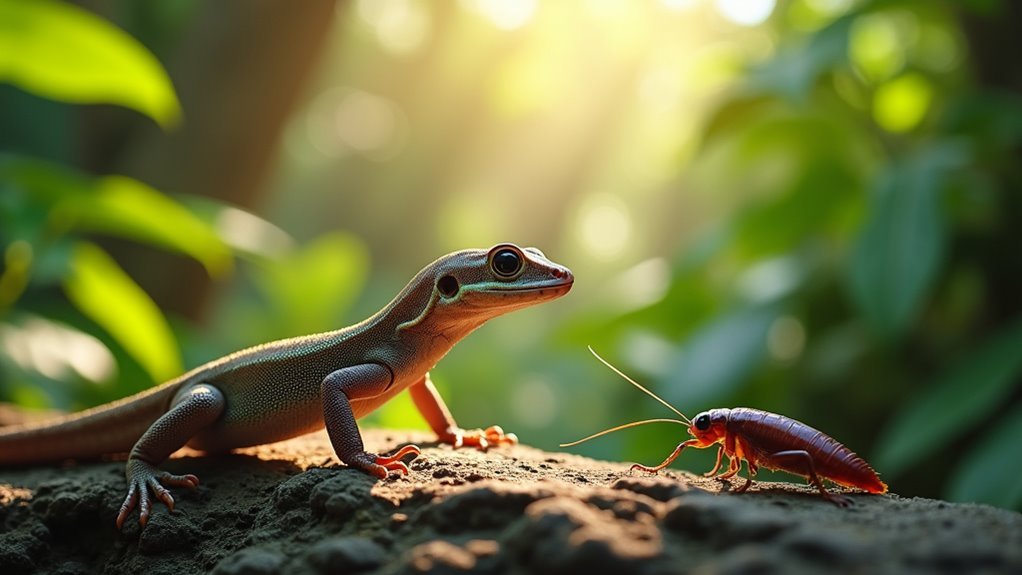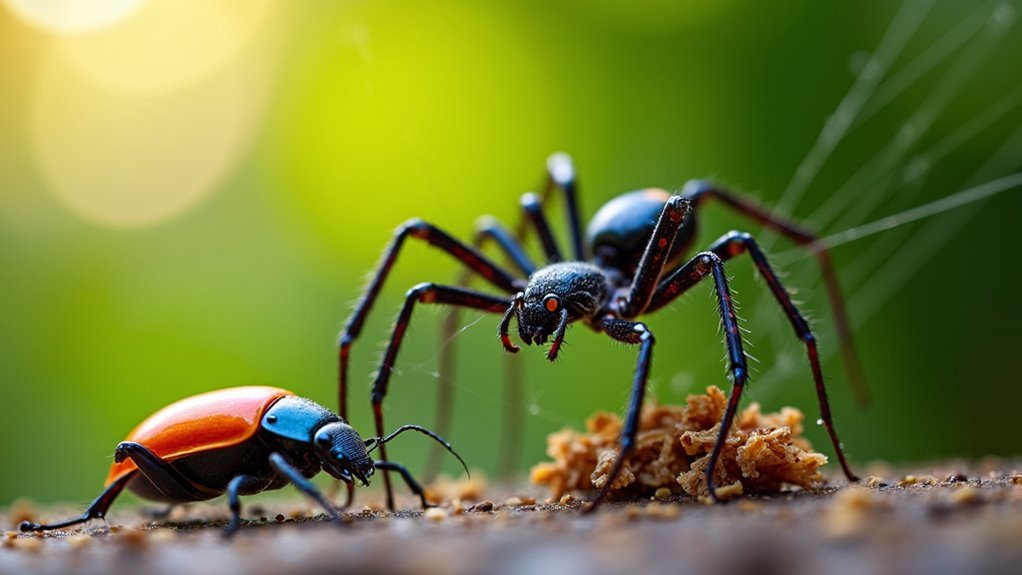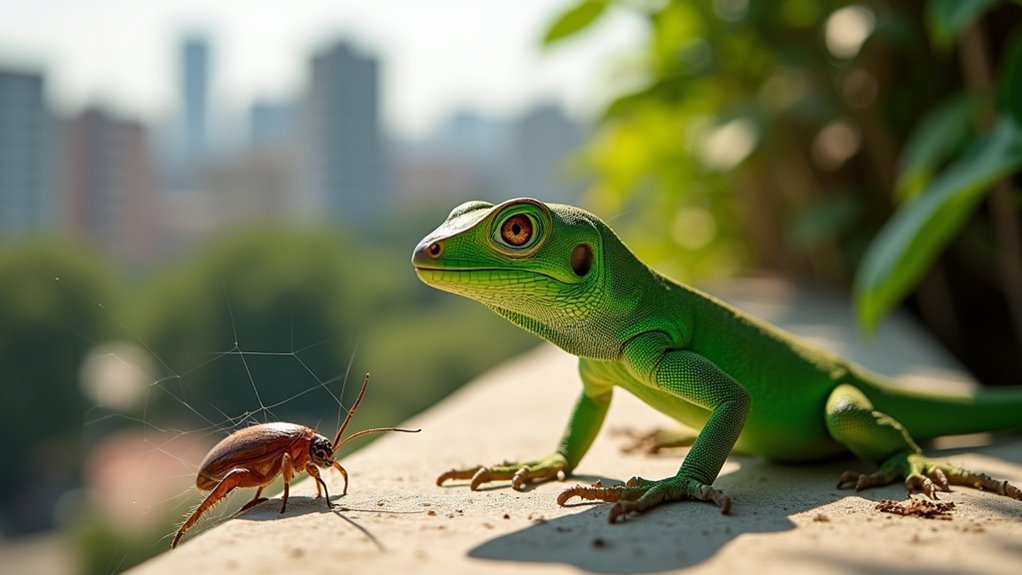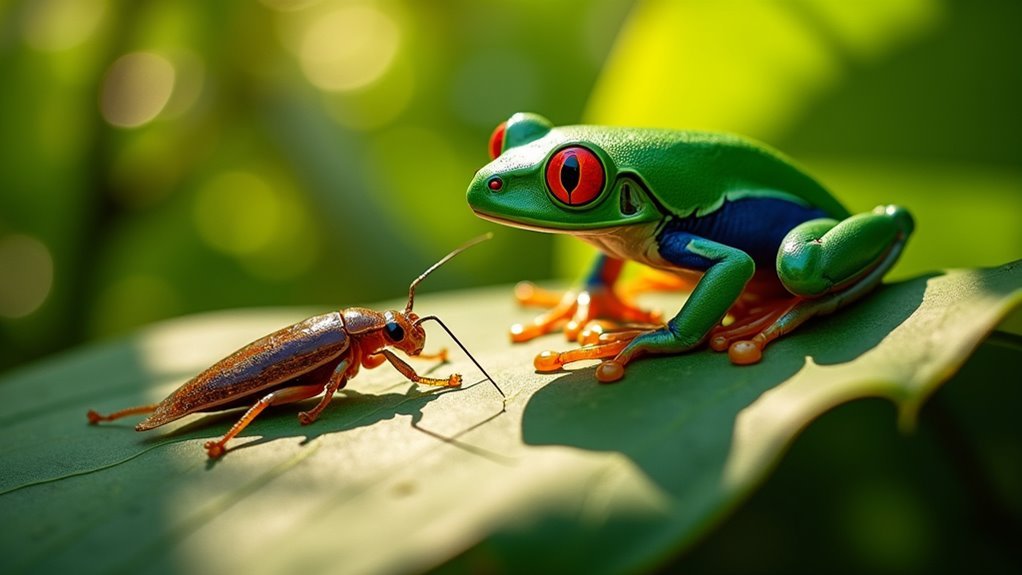Natural predators excel at cockroach control because they target multiple life stages simultaneously – parasitic wasps inject eggs into cockroach bodies, spiders use webs and ambush tactics for adults, while beetles destroy eggs and hunt juveniles. You’ll find they create self-sustaining population management without chemicals, establishing predator-prey dynamics that maintain long-term suppression. Their synchronized life cycles with cockroaches enhance effectiveness, and their combined efforts form sustainable pest management systems that’ll provide deeper insights into biological control strategies.
Types of Natural Cockroach Predators in Different Ecosystems

When you’re dealing with cockroach infestations, understanding the natural predators in your specific ecosystem can make all the difference in effective control.
In urban environments, you’ll find small mammals and birds effectively managing cockroach populations through their natural foraging behaviors. These areas also benefit from non-native predator species like certain ants, though you’ll need careful management to avoid ecological consequences.
Rural ecosystems typically rely more on predatory insects and arachnids for control. Web-weaving spiders and beetles actively hunt cockroaches in their natural habitats, while parasitic wasps lay eggs inside roaches. Rove beetles specifically target juvenile roaches and their eggs.
Your ecosystem’s climate and biodiversity directly impact predator success, making location-specific pest management practices essential for ideal results.
How Parasitic Wasps Target Cockroach Populations
Although parasitic wasps might seem tiny and insignificant, they’re actually among nature’s most efficient cockroach eliminators. These specialized insects target cockroaches through a remarkably precise hunting strategy. Female wasps inject their eggs directly into cockroach bodies, where larvae develop by feeding on the host from within. This process inevitably kills the cockroach while producing new wasps.
What makes these predators exceptionally effective is their synchronized life cycle with their prey. When cockroach populations surge, wasps have increased reproductive opportunities, naturally balancing the ecosystem. Some species even target cockroach egg cases, preventing entire generations from emerging.
Modern pest management strategies increasingly incorporate parasitic wasps for biological control, reducing chemical pesticide dependency while maintaining long-term population suppression through natural predator-prey relationships.
The Role of Spiders and Beetles in Cockroach Management

You’ll find that spiders and beetles represent two of nature’s most effective cockroach control agents, each employing distinct hunting strategies to reduce pest populations.
Spiders use their intricate webs as sophisticated traps to capture cockroaches, while beetles actively hunt down juvenile roaches and destroy their eggs before they can mature.
When you combine these predators in your pest management approach, they’ll work together to create a natural control system that’s often more sustainable than chemical treatments alone.
Spider Hunting Mechanisms
While many homeowners struggle with cockroach infestations, spiders serve as highly effective natural predators that can markedly reduce these pest populations through their sophisticated hunting mechanisms.
You’ll find that web-weaving spiders excel at cockroach control by strategically positioning silk webs to ensnare unsuspecting prey. These predators don’t rely solely on passive trapping – many species demonstrate advanced hunting techniques that make them formidable opponents against cockroaches.
You can observe spiders employing ambush tactics, where they wait motionlessly before striking with lightning speed. Others actively pursue their cockroach targets, using superior agility and precision.
These diverse hunting strategies guarantee that spiders capture cockroaches effectively, making them invaluable allies in natural pest management systems that reduce your dependence on harmful chemical pesticides.
Beetle Predation Strategies
Beetles complement spiders’ hunting prowess with their own specialized predation strategies that target cockroaches at their most vulnerable life stages. Rove beetles excel as natural predators by aggressively hunting juvenile cockroaches and consuming their eggs, delivering devastating blows to cockroach populations before they can mature and reproduce.
You’ll find these beetles particularly effective because they attack roaches when they’re defenseless and can’t escape. Unlike spiders that primarily catch adult cockroaches, beetles focus on prevention by eliminating the next generation.
This strategic approach makes them invaluable for long-term pest control. When you maintain environments that support beetle populations, you’re investing in sustainable ecological balance that doesn’t require chemical interventions while dramatically reducing future cockroach infestations.
Combined Control Effectiveness
When spiders and beetles work together in your environment, they create a thorough cockroach control system that’s more effective than either predator operating alone.
You’ll benefit from spiders’ web-weaving abilities capturing adult cockroaches while rove beetles target juveniles and eggs, disrupting the entire lifecycle. This natural partnership enhances biodiversity in your space, creating a self-regulating ecosystem that continuously manages cockroach populations.
In urban settings, you’ll find these adaptable predators particularly valuable since they counter cockroaches’ advantages of abundant food and shelter.
Your pest management strategy becomes more sustainable when you support both spider and beetle populations. Monitor their presence regularly to guarantee this effective natural control system functions properly, reducing your reliance on chemical interventions against these persistent pests.
Effectiveness of Natural Predators in Urban Vs Rural Settings

Although urban and rural environments present vastly different ecosystems, they both harbor natural predators that can effectively control cockroach populations, though their success rates vary considerably based on environmental factors.
In urban settings, you’ll find small mammals and birds serving as primary predators, while rural environments support diverse predatory insects like rove beetles and spiders that excel at targeting juvenile cockroaches.
| Environment | Primary Predators | Target Stage | Effectiveness | Challenges |
|---|---|---|---|---|
| Urban | Birds, small mammals | Adults | Moderate | Abundant food sources |
| Rural | Rove beetles, spiders | Juveniles/eggs | High | Weather dependency |
| Both | Various insects | All stages | Variable | Habitat conditions |
However, urban predation faces significant challenges from abundant food sources and ideal hiding spots that compromise natural control effectiveness, requiring careful monitoring of predator-prey interactions.
Ecological Benefits of Biological Cockroach Control
You’ll discover that introducing natural predators doesn’t just control cockroaches—it actively enhances your local ecosystem’s biodiversity by creating balanced food webs that support numerous beneficial species.
When you choose biological control over chemical pesticides, you’re fostering a chemical-free environment where predatory beetles and parasitic wasps naturally regulate pest populations without contaminating soil or water sources.
This approach establishes self-sustaining ecological harmony that maintains itself through natural predator-prey dynamics, eliminating your need for constant human intervention.
Biodiversity Enhancement Through Predation
Since natural predators target cockroaches as part of their normal feeding behavior, they create a ripple effect that strengthens entire ecosystems. When you introduce natural predators into your environment, you’re enhancing biodiversity while establishing sustainable pest management. These predators don’t just control cockroach populations—they contribute to balanced food webs that support various species.
| Predator Type | Primary Ecological Role | Biodiversity Impact |
|---|---|---|
| Spiders | Web builders/hunters | Habitat structure creation |
| Geckos | Nocturnal controllers | Vertical ecosystem balance |
| Centipedes | Ground-level predators | Soil ecosystem health |
| Birds | Aerial surveillance | Cross-habitat connectivity |
| Parasitic wasps | Targeted elimination | Specialized niche filling |
You’ll find that ecological benefits extend beyond cockroach control, as these predator-prey relationships foster ecosystem resilience and maintain natural nutrient cycling throughout your habitat.
Chemical-Free Ecosystem Balance
Beyond supporting diverse wildlife populations, natural predator systems eliminate your dependence on chemical pesticides while creating self-sustaining ecological balance.
When you introduce rove beetles and parasitic wasps into your environment, you’re establishing a chemical-free approach that prevents pest resistance development. Unlike repeated pesticide applications that create resistant cockroach populations, natural predators maintain consistent control through biological processes.
This sustainable pest management strategy aligns perfectly with Integrated Pest Management principles, combining multiple control methods without environmental risks.
You’ll notice how these predators integrate seamlessly into existing food webs, maintaining soil and plant health by preventing cockroach population explosions. The result is a balanced ecosystem that regulates itself naturally, reducing your need for harmful interventions while promoting long-term ecological harmony and health benefits.
Integrating Natural Predators Into Pest Management Strategies
When you integrate natural predators like rove beetles and parasitic wasps into your pest management strategy, you’ll create a powerful defense system that targets cockroaches at their most vulnerable stages.
These beneficial insects excel at eliminating juvenile cockroaches and their eggs, dramatically reducing cockroach populations over time.
Your success depends on implementing a thorough Integrated Pest Management (IPM) approach that combines multiple strategies:
- Maintain cleanliness and proper waste management to support predator effectiveness
- Monitor predator populations regularly to assess their impact on cockroach control
- Create habitat modifications that encourage predator establishment in urban environments
You’ll need public cooperation to maintain predator-friendly environments while avoiding harmful chemicals.
This ecosystem-based approach minimizes pesticide reliance while maximizing long-term cockroach control through natural biological processes.
Environmental Factors That Enhance Predator Success
While natural predators possess inherent hunting abilities, their success in controlling cockroach populations depends heavily on the environmental factors you create and maintain.
In urban settings, you’ll notice small mammals and birds thrive due to abundant food sources and shelter options. Rural environments favor predatory insects like rove beetles and spiders, which flourish in diverse habitats supporting their complete life cycles.
You must consider habitat conditions including moisture levels and vegetation density, as these directly impact predator effectiveness.
Creating a balanced ecosystem with high biodiversity enhances your pest management efforts by establishing a stable food web.
You should monitor predator populations and their cockroach interactions to understand how environmental conditions influence natural predators’ success in your specific setting.
Overcoming Challenges in Natural Predator Implementation
Despite creating ideal environmental conditions for natural predators, you’ll encounter significant obstacles when implementing these biological control strategies in real-world settings.
You’ll face three primary challenges when integrating natural predators into effective pest management:
- Access limitations – Cockroach populations hide in cracks, walls, and inaccessible areas where predators can’t reach them effectively.
- Chemical interference – Pesticide use disrupts ecological balance by harming beneficial predators alongside target pests.
- Urban habitat modifications – Cities provide abundant food and shelter for cockroaches while creating hostile environments for predator establishment.
You’ll need public cooperation and strategic urban habitat modifications to overcome these barriers.
Success requires balancing chemical treatments with biological controls, ensuring predators can access cockroach populations while maintaining the ecological balance necessary for sustainable pest management.
Sustainable Alternatives to Chemical Cockroach Control
As environmental concerns and pesticide resistance issues mount, you’ll find that sustainable cockroach control methods offer compelling advantages over traditional chemical approaches.
Natural predators like parasitic wasps and rove beetles provide environmentally responsible solutions that effectively manage cockroach populations without introducing harmful substances into your ecosystem. These sustainable alternatives prevent the development of pest resistance that plagues repeated chemical treatments, ensuring long-term effectiveness.
You’ll benefit from integrated pest management strategies that combine natural predators with cultural and mechanical controls, creating a holistic approach to pest regulation.
Frequently Asked Questions
Is There a Natural Predator for Cockroaches?
Yes, you’ll find several natural predators that hunt cockroaches. Parasitic wasps target their egg cases, while rove beetles eat juveniles and eggs. Spiders, small mammals, and birds also effectively control cockroach populations naturally.
Why Are Humans Naturally Afraid of Cockroaches?
You’re naturally afraid of cockroaches because they move unpredictably and quickly, triggering your fight-or-flight response. They’re also associated with disease and filth, making your brain perceive them as threats to avoid.
What Animal Are Cockroaches Scared Of?
You’ll find cockroaches are most scared of spiders, parasitic wasps, and small mammals like mice. These natural predators actively hunt them, making cockroaches instinctively flee to dark hiding spots.
What Animal Kills the Most Cockroaches?
You’ll find that birds like sparrows and starlings kill the most cockroaches. They’re incredibly effective hunters with constant foraging habits, making them the top predators for controlling cockroach populations in urban areas.
In Summary
You’ve seen how natural predators offer superior cockroach control through targeted hunting, reproductive disruption, and ecosystem balance. By implementing biological solutions, you’re choosing sustainable pest management that doesn’t harm your environment or health. Whether you’re integrating parasitic wasps, encouraging spider populations, or creating predator-friendly conditions, you’re investing in long-term control that adapts and evolves. Natural predators don’t just eliminate cockroaches—they transform your space into a self-regulating ecosystem that prevents future infestations effectively.





Leave a Reply